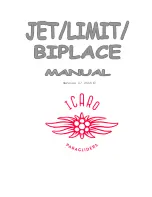
7
Limits of use
The AROLLA 2 paragliders are certified for solo free flight only. Weather and thermal
conditions must remain suitable for paragliding at any time and the very skills of the
pilot have to be taken into account to decide whether to fly or not. Moderate winds (4
on the Beaufort scale or 20-28 km/h) can already be tricky due to turbulence near the
ground on the leeward side behind obstacles or wind shears created by thermal
activity
Acrobatic manœuvres, which are manoeuvres during which the canopy dives in pitch
or roll over 30° from the trim straight glide shall not be considered as the normal use
of your AROLLA 2 paraglider.
The pilot must comply at any time with laws and regulations applicable to paragliding.
The pilot should also comply with the requirements resulting from the certification
(take-off load, dimensions of the harness, lines setting, brakes setting, etc.) and the
safety information provided by this manual.
The behaviour of the AROLLA 2 when used on the winch or with an engine
(paramotor) is not part of the certification according to the EN 926-2: 2013 standard.
Operating the AROLLA 2
The AROLLA 2 requires no special or unusual operating technique. However you’ll
find hereunder some useful reminder which might help you to become more familiar
with your new wing.
Preflight check of the paraglider
Check of the canopy:
check the canopy for wears ; also check that the inner
structure (ribs and diagonals) is not damaged and that the seams are all right.
Check of the lines:
check that the lines, including the seams and the end loops are
not damaged. Also check that the lines are not tangled and are perfectly sorted out.
Check of the rapid links:
check that all the rapid links are screwed tight.
Contrôle of the risers:
check that the risers are not damaged and are not twisted or
tangled. Check that the speed system can be operated freely and that the ropes are
long enough as to avoid unintended operation of the speed system. Check that the
brake handles are in correct position and that the brake lines run freely through the
barke pulleys.
Take-off
Lay out the paraglider with the leading edge
in a horseshoe shape
. Holding the A
risers close to the quick links move forward until the lines are tight.
You should now be perfectly centered in your wing. In nil wind or a light headwind,
with lines tight take several strides. AROLLA 2 will rapidly inflate and rise over your
head.
Do not pull the risers too hard, either forward or down as this could cause a collapse
of the leading edge. Simply follow them with your arms until the glider reaches its
Содержание AROLLA 2
Страница 3: ...3 Sectional drawing of the AROLLA 2 ...
Страница 4: ...4 Plan of the lines ...
Страница 5: ...5 Drawing of the risers ...





















